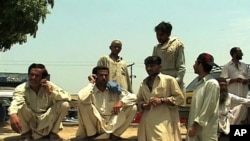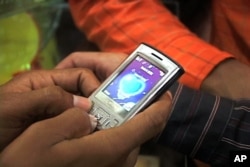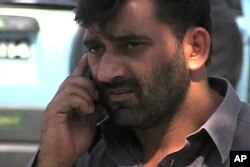Every night at dusk in certain parts of Afghanistan, cell phone service is abruptly cut off until early the next morning, leaving mobile phone users in a black hole of communication. Companies that provide mobile service in Afghanistan do so under threat of attack by Taliban insurgents, whose goal is to stop U.S. and NATO forces from tracking militant communications and to block local Afghans from passing tips to the authorities.
Out of a population of just over 28 million people, it’s estimated that more than 40 percent of Afghans have access to or own a mobile phone, a key means of communication in a country where landline phone infrastructure has been weakened by decades of war.
Altaf Ladak is the chief operating officer for Roshan company, which claims 35 percent of the mobile market share in Afghanistan. He does not believe his company is playing into the hands of the Taliban by bowing to demands to shut off cell phone access at night, saying instead that it is simply a matter of security, a decision made in consultation with all mobile operators in Afghanistan – a country, he says, that is difficult at best to operate in.
“We needed to make sure our people and our assets are secure. So as a whole, as an industry, we’ve taken that precaution to make sure that none of our people are put at risk or any of our sites.”
In the past, Afghan insurgents have blown up and destroyed expensive cell towers and threatened operators, even though the insurgents themselves rely on mobile devices to plan their attacks.
Etisalat Afghanistan is another mobile service provider in Afghanistan, with an estimated 3.2 million subscribers. The company imposes blackouts in several traditional Taliban strongholds; the southern provinces of Kandahar and Helmand and Ghazni, to the east. Vice President of Corporate Affairs Ameer Eshaq admits the blackouts deny Afghans a primary means of communication, but adds the policy has the support and understanding of the local population.
Nonetheless, the effect is one of control. And cutting of mobile service is just one of many tools – some high tech, some more traditional, like mobile radio stations and printed leaflets – that are used as part of an effective communications strategy by Islamic extremists. Top U.S. policy makers have taken note and are now preparing to launch their own counter-communications campaign to override militant messaging in militant-infested regions on both sides of the Afghanistan-Pakistan border.
Controlling and shaping the flow of information lies at the heart of extremists’ communications strategy. It is designed to play to specific audiences, which, in addition to local populations in both Afghanistan and Pakistan, include U.S. and NATO forces, Afghan and Pakistani authorities and, of course, the larger pan-Islamic world and the West.
Another way is to message the media. Some journalists receive SMS messages and regular calls on their mobile phones, offering interviews and claiming responsibility for terrorist attacks against Afghan, Pakistani and Western targets.
A newer, surprising strategy even involves emailing news alerts written in perfect English to western reporters that detail one successful attack after another on the battlefield. And, of course, there are dozens of websites used to recruit and train militants, and to post insurgent messages and videos.
Countering extremist messaging is actively on the minds of top U.S. officials who, as part of President Obama’s Afghanistan-Pakistan revamped strategy, know they must catch up on the communications side of the war on terror. In fact, this year the Obama administration is set to spend more than $300 million on such efforts in both Afghanistan and Pakistan.
Rear Admiral Greg Smith, director of communications for U.S. and NATO forces currently deployed in Afghanistan, says a key part of that plan is to stop the Taliban-enforced mobile phone blackouts.
“What we’re going to do is we’re going to is build a backbone that’s not vulnerable to the insurgents that will be built, as you can well imagine onboard, on our facilities where we have good security and from that, we’ll be able to radiate a signal back out into the population and for our own security forces, one that the Taliban won’t be able to influence and take down. That same tower will be able to hang radio and television transmitters on and, partnering with existing television and radio, broadcast signals into neighborhoods and area and villages, rural areas that have been cleared recently by our forces and, in some cases, perhaps bringing radio and television for the first time.”
Admiral Smith says other programs include underwriting religious radio programming for Afghans, posting public billboards that tell people about the work of the Afghan government and encouraging local Afghan elders to hold jirgas and shuras – or traditional community meetings – in rural areas.
This ambitious effort to gain control of the narrative, as top U.S. officials put it, will be conducted in a difficult and hostile atmosphere, one where many Afghans and Pakistanis inherently distrust the motives of the United States government.
Dr. Carsten Bockstette is a researcher, author and analyst at the George C. Marshall Center for European Security Studies in Germany. He has written several papers examining the propaganda techniques of Islamic extremists.
“We have to do something about the strategic communications that the jihadists and Taliban are using and doing. It is of the essence that we don’t lose our own credibility. Ensuring our own credibility while undermining the jihadist credibility is one of the key elements.”
He gives this example: U.S. and NATO forces must quickly and honestly take responsibility for Afghan and Pakistani civilian deaths – an extremely sensitive issue that strengthens extremist recruitment efforts - that sometimes occur when CIA-operated pilotless aircraft target insurgent bases.
But even in the digital age, Bockstette believes the most effective way to compete with the insurgent point of view is to start from the bottom up. He says identifying and employing local and trusted “storytellers” who can conduct what he calls a “mouth-to-mouth” campaign that rejects Islamic extremist ideology is critical to successfully penetrating largely rural communities where insurgents exploit poverty, illiteracy and weak local governance.








